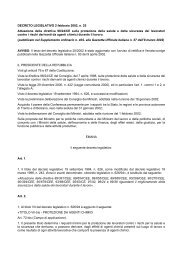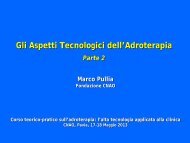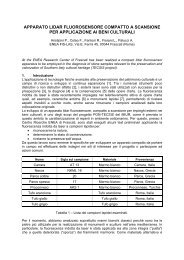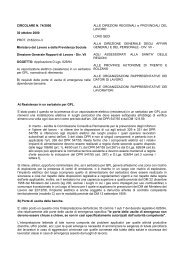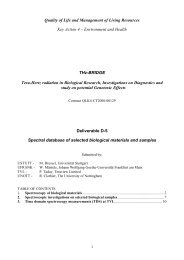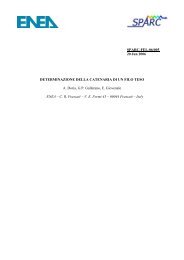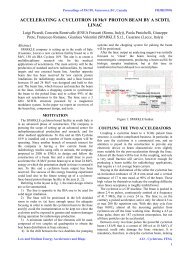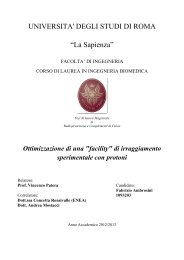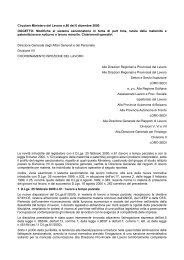Theory, Design and Tests on a Prototype Module of a Compact ...
Theory, Design and Tests on a Prototype Module of a Compact ...
Theory, Design and Tests on a Prototype Module of a Compact ...
You also want an ePaper? Increase the reach of your titles
YUMPU automatically turns print PDFs into web optimized ePapers that Google loves.
4. BRIDGE COUPLERS DESIGN 35<br />
4. Bridge Couplers design<br />
The bridge coupler has a fundamental role in a Side Coupled Linac.<br />
It allows to have tanks which are separated by magnetic quadrupoles<br />
<str<strong>on</strong>g>and</str<strong>on</strong>g> fed by the same RF waveguide. In the figure 3.10 a sketch <strong>of</strong> this<br />
functi<strong>on</strong>ality is shown.<br />
Figure 3.10. Schematic view <strong>of</strong> the Bridge Coupler<br />
functi<strong>on</strong>ality. The Bridge Coupler cavity couple two<br />
tanks <str<strong>on</strong>g>and</str<strong>on</strong>g> leaves the space for a Permanent Quadrupole<br />
Magnet by which the particles beam is focused.<br />
Of course, the Bridge Couplers are particular cells, the design <strong>of</strong><br />
which should be c<strong>on</strong>ceived paying attenti<strong>on</strong> to different claims with<br />
respect to the accelerating <str<strong>on</strong>g>and</str<strong>on</strong>g> coupling cavities.<br />
Not so many Bridge Couplers have been realized in the accelerators<br />
community. The few examples are the <strong>on</strong>es for the 800 MHz Side<br />
Coupled Linac in the Los Alamos Nati<strong>on</strong>al Laboratory [19], <str<strong>on</strong>g>and</str<strong>on</strong>g> the<br />
800 MHz Side Coupled Linac in the FermiLab in Chicago. For these<br />
linacs, the bridge couplers was c<strong>on</strong>nected to coupling cells, therefore,<br />
from the electromagnetic point <strong>of</strong> view they were analogous to accelerating<br />
cells.<br />
In this case, <strong>on</strong>e could think to a single cavity bridge coupler which<br />
directly c<strong>on</strong>nects two accelerating cells but mode mixing could arise 7 .<br />
The res<strong>on</strong>ant mode we choose has to be far away from the others to<br />
avoid mode mixing.<br />
In a LIBO module there are three Bridge Couplers. One is c<strong>on</strong>nected<br />
with the feeding waveguide through an iris (see figure 3.11),<br />
<str<strong>on</strong>g>and</str<strong>on</strong>g> the other two have pumping ports for the vacuum. In order to<br />
reduce the overall dimensi<strong>on</strong>s, it has been chosen a bridge coupler including<br />
also two coupling cells, which, <strong>of</strong> course, are specially designed.<br />
The principal quality <strong>of</strong> such a structure is the transit time <strong>of</strong> energy<br />
which is equal to the length <strong>of</strong> the bridge coupler divided by the group<br />
velocity <strong>of</strong> the cavity mode. As the bridge coupler length is determined<br />
by other c<strong>on</strong>siderati<strong>on</strong>s, the principal figure <strong>of</strong> merit for a particular<br />
bridge coupler c<str<strong>on</strong>g>and</str<strong>on</strong>g>idate is its group velocity, the higher the better<br />
[29].<br />
7 Due to a finite quality factor <strong>of</strong> the res<strong>on</strong>ant cavities, more than <strong>on</strong>e mode<br />
could be excited from a frequency t<strong>on</strong>e <str<strong>on</strong>g>and</str<strong>on</strong>g> this phenomen<strong>on</strong> is called Mode mixing.







